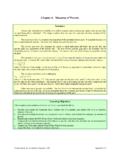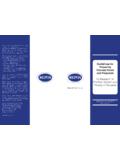Transcription of Chapter 6. Inequality Measures
1 poverty Manual, All, JH Revision of August 8, 2005 Page 95 of 218 Chapter 6. Inequality Measures Summary Inequality is a broader concept than poverty in that it is defined over the entire population, and does not only focus on the poor. The simplest measurement of Inequality sorts the population from poorest to richest and shows the percentage of expenditure (or income) attributable to each fifth (quintile) or tenth (decile) of the population. The poorest quintile typically accounts for 6-10% of all expenditure, the top quintile for 35-50%. A popular measure of Inequality is the Gini coefficient, which ranges from 0 (perfect equality) to 1 (perfect Inequality ), but is typically in the range of for per capita expenditures.
2 The Gini is derived from the Lorenz curve, which sorts the population from poorest to richest, and shows the cumulative proportion of the population on the horizontal axis and the cumulative proportion of expenditure (or income) on the vertical axis. While the Gini coefficient has many desirable properties mean independence, population size independence, symmetry, and Pigou-Dalton Transfer sensitivity it cannot easily be decomposed to show the sources of Inequality . The best-known entropy Measures are Theil s T and Theil s L, both of which allow one to decompose Inequality into the part that is due to Inequality within areas ( urban, rural) and the part that is due to differences between areas ( the rural-urban income gap).
3 Typically at least three-quarters of Inequality in a country is due to within-group Inequality , and the remaining quarter to between-group differences. Atkinson s class of Inequality Measures is quite general, and is sometimes used. The decile dispersion ratio defined as the expenditure (or income) of the richest decile divided by that of the poorest decile is popular but a very crude measure of Inequality . It is often helpful to decompose Inequality by occupational group, or by source of income, in order to identify policies that would help moderate Inequality . Learning Objectives After completing the module on poverty lines, you should be able to: 21. Explain what Inequality is, and how it differs from poverty .
4 22. Compute and display information on expenditure (or income) quintiles. 23. Draw and interpret a Lorenz curve. 24. Compute and explain the Gini coefficient of inquality. 25. Argue that the Gini Coefficient satisfies mean independence, population size independence, symmetry, and Pigou-Dalton Transfer sensitivity, but is not easily decomposable. 26. Compute and interpret generalized entropy Measures , including Theil s T and Theil s L. 27. Compute and interpret Atkinson s Inequality measure for different values of the weighting parameter . 28. Compute and criticize the decile dispersion ratio. 29. Decompose Inequality using Theil s T in order to distinguish between-group from within-group components of Inequality , for separate geographic areas, occupations, and income sources.
5 poverty Manual, All, JH Revision of August 8, 2005 Page 96 of 218 Definition of Inequality The main focus of this manual is on poverty , which looks at the situation of individuals or households who find themselves at the bottom of the income distribution; typically this requires information both about the mean level of (say) expenditure per capita as well as its distribution at the lower end. But sometimes we are more interested in measuring Inequality than poverty per se, and for that reason we have included this relatively brief Chapter on measuring Inequality . Inequality is a broader concept than poverty in that it is defined over the entire population, and not just for the population below a certain poverty line.
6 Most Inequality Measures do not depend on the mean of the distribution, and this property of mean independence is considered to be a desirable property of an Inequality measure . Of course, Inequality Measures are often calculated for distributions other than expenditure for instance, for income, land, assets, tax payments, and many other continuous and cardinal variables. The simplest way to measure Inequality is by dividing the population into fifths (quintiles) from poorest to richest, and reporting the levels or proportions of income (or expenditure) that accrue to each level. Table shows the level of expenditure per capita, in '000 dong per year, for Vietnam in 1993, based on data from the Vietnam Living Standards Survey.
7 A fifth of the individuals (not households) included in the survey were allocated to each expenditure quintile. The figures show that of all expenditures were made by the poorest fifth of households, and by the top fifth. Quintile information is easy to understand, although sometimes one wants a summary measure rather than a whole table of figures. Table : Breakdown of expenditure per capita by quintile, Vietnam 1993 Expenditure quintiles Lowest Low-mid Middle Mid-upper Upper Overall Per capita expenditure ('000 dong/year) 518 756 984 1,338 2,540 1,227 % of expenditure Memo: Cumulative % of expenditure * Memo: Cumulative % of population Source: Vietnam Living Standards Survey 1993.
8 Note: * There is a slight rounding error here. poverty Manual, All, JH Revision of August 8, 2005 Page 97 of 218 Commonly used summary Measures of Inequality Gini coefficient of Inequality The most widely used single measure of Inequality is the Gini coefficient. It is based on the Lorenz curve, a cumulative frequency curve that compares the distribution of a specific variable ( income) with the uniform distribution that represents equality. To construct the Gini coefficient, graph the cumulative percentage of households (from poor to rich) on the horizontal axis and the cumulative percentage of expenditure (or income) on the vertical axis.
9 The Lorenz curve shown in figure 1 is based on the Vietnamese data in Table The diagonal line represents perfect equality. The Gini coefficient is defined as A/(A+B), where A and B are the areas shown on the graph. If A=0 the Gini coefficient becomes 0 which means perfect equality, whereas if B=0 the Gini coefficient becomes 1 which means complete Inequality . In this example the Gini coefficient is about Lorenz Curve01020304050607080901000 2040 6080100 Cumulative % of populationCumulative % of expenditure Figure Lorenz Curve Formally, let xi be a point on the X-axis, and yi a point on the Y-axis. Then B A poverty Manual, All, JH Revision of August 8, 2005 Page 98 of 218 ( ).
10 ((1111 = + =NiiiiiyyxxGini When there are N equal intervals on the X-axis this simplifies to ( ) .)(1111 = + =NiiiyyNGini For users of Stata, there is a gini command that may be downloaded and used directly (see Appendix 3). This command also has the advantage that it allows one to use weights, which are not incorporated into the two equations shown above. The Gini coefficient is not entirely satisfactory. To see this, consider the criteria that make a good measure of income Inequality , namely: Mean independence. This means that if all incomes were doubled, the measure would not change. The Gini satisfies this. Population size independence. If the population were to change, the measure of Inequality should not change, ceteris paribus.))















